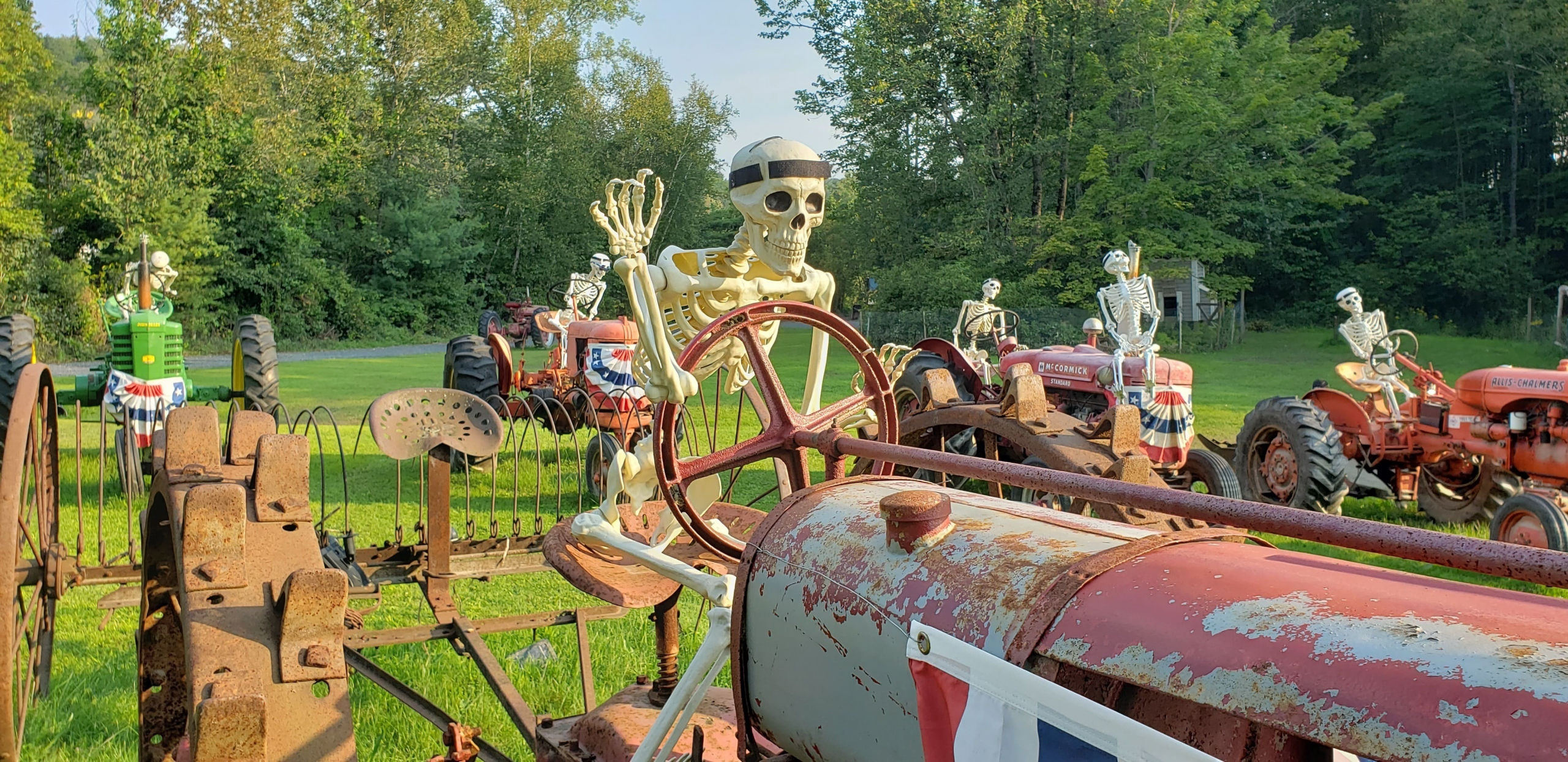Farmers have steadily declined as a share of the American workforce since the Dust Bowl of the 1930s, undermined by technological advances, regulatory strictures, and industry consolidation in farming. Larger farms on ever-pricier land bar new entrants, and a handful of corporations are increasing their domination of food production. Both farm operators and migrant workers are aging, while globalists push unnatural industrial food substitutes that can be grown in a lab without hands in the field.
Technology has always illusorily made big promises to farmers, keeping the downsides in the shadows. The reality is that tractors have compacted soils; plows have tilled lands into erosion and water loss; chemicals, synthetic fertilizers, and confinement feed operations have replaced traditional husbandry. In an odd parallel, humanity has irrevocably and abruptly shifted from a balanced agriculture where people were tied through communities to one another, their plants and livestock, and the soil, water, and sun that sustained them. What was hitherto achieved through clean, renewable solar power (blades of grass and grain, fueled by photosynthesis) is now accomplished by technology. Moderns embrace a machine-dependent technocratic agriculture, subduing endless horizons with computer-guided titanic tractors to be one day, we are told, powered by factory-manufactured solar panels.
From solar to solar, from life to machine. Imagine what the next leap in food production will be, as artificial intelligence softly smooths the covers for humanity to lie down in techno-dependency. We are reaching beyond slavery to that unthinkable time when a man is no longer valued for his labor and has become superfluous.
Farmer Attrition
As machines and corporate greed have destroyed local, small-scale agriculture, farmers have diminished in numbers. The hangers-on are crook-kneed and wrinkling: The average age of American farmers is now 60. More people have been switching to farming careers, but even there, the average was 46.3 years in the 2017 Census, and new farms are more likely to be smaller in size.
Farming is a high-capital, low-margin enterprise, favoring older landowners with accumulated funds. Inflation and demand have pushed farmland prices up more than 7% a year recently, discouraging many would-be growers. Consequently, in 2019 some one-third of America’s 3.4 million farmers were over 65, and nearly another million were over 55. Lands, factories, and feedlots consolidate ever larger as the pool of land stewards shrivels.
Migrant Farmworkers Aging Too

(Photo credit Liberty Nation)
This contraction of the human portion of the food-producing chain is limited not only to principal operators but also to migrant labor. In 2012, the average age of an American farmworker was 36. The National Center for Farmworker Health stated that “the age of agricultural workers in the United States has been increasing since 2000”: 17% are between 14-24 compared to 35% in 1999-2000, and 14% are over 55, compared to merely 5% in 1999-2000. It is not just expensive land prices discouraging farm labor but rapid mechanization.
Notwithstanding calls for better wages for migrant labor, few consumers appreciate that many farmers work not only for less than minimum wage but also at times a negative wage. When milk or other farm product prices plummet, family farmers (not their paid workers) must absorb higher costs and keep feeding animals that are losing money minute by minute.
Indeed, for much of the past century, family farmers have suffered through a real-life Steinbeckian tragedy. The US Department of Agriculture reported:
“The reduction in self-employed and family labor through 1990 was more rapid than the decline in hired labor. According to data from the Farm Labor Survey (FLS) of USDA’s National Agricultural Statistical Service (NASS), the number of self-employed and family farmworkers declined from 7.60 million in 1950 to 2.01 million in 1990, a 74-percent reduction. Over this same period, average annual employment of hired farmworkers — including on-farm support personnel and those who work for farm labor contractors — declined from 2.33 million to 1.15 million, a 51-percent reduction. As a result, the proportion of hired workers has increased over time.”

(Photo credit Liberty Nation)
Both migrant farm workers and farm operators/owners are getting older, and corporations and mechanization continue to seize the day – and the food supply. Many young people seek to return to the land and turn the soil to turn a profit. This is especially visible since COVID, and at least partly explains the rising prices for rural agricultural plots as San Francisco and Portland real estate prices head for the manure pile. Policies could instead be fashioned to secure a next generation not of GMOs and macabre splicing of plant-animal-microbe genes, but good old-fashioned pitchfork-in-hand American Gothic land stewards.
Foreign Farming Dependency?
The crisis of American farmer attrition isn’t some quaint nostalgia for a Little House on the Prairie idealism but a practical economic, cultural, and health matter. One contributor to farm-income decline is globalization and increasing foreign food dependency. The USDA reported:
“In 2023, net farm income is expected to decrease by 18.2 percent relative to 2022. Farm production expenses are projected to increase 11.0 percent in 2022 relative to 2021 and 1.3 percent from 2022 to 2023 … Total U.S. agricultural trade rose to record levels in 2021. U.S. agricultural exports were valued at $177 billion in 2021, an 18 percent increase relative to 2020. Imports grew by almost 17 percent in 2021 to $171 billion. While the United States typically exports more agricultural goods by value than it imports, from 2012–21, imports grew more rapidly than exports.”
 Fostering dependency on foreign, corporate-dominated, highly consolidated, processed, techno-dependent foods shipped long distances threatens food security and international competitiveness. Policies that favor large corporate producers only add to this dependency, especially subsidies for monoculture crops like corn, wheat, and soy. To reverse this dangerous trend, regulatory, tax, and fiscal benefits could be offered to new market entrants, particularly for the acquisition and retention of fertile farmlands, many of which are being lost to development or lapsing into forest-growing carbon sequestration (grasslands sequester far more carbon than trees, and beef tastes better than cordwood!).
Fostering dependency on foreign, corporate-dominated, highly consolidated, processed, techno-dependent foods shipped long distances threatens food security and international competitiveness. Policies that favor large corporate producers only add to this dependency, especially subsidies for monoculture crops like corn, wheat, and soy. To reverse this dangerous trend, regulatory, tax, and fiscal benefits could be offered to new market entrants, particularly for the acquisition and retention of fertile farmlands, many of which are being lost to development or lapsing into forest-growing carbon sequestration (grasslands sequester far more carbon than trees, and beef tastes better than cordwood!).
Bill Gates is not accumulating farmland so he can tool around in his cardigan on a John Deere tractor practicing inorganic farming. He advocates for bug diets imposed by regulatory fiat, fake meat made of GMO soy and calf fetal tissue (for which he owns the patents), preserved with his unappealing APEEL (another patent). If Americans don’t want Bill determining what’s for supper, they had better incentivize some young hands to tend the land pronto – from sea to shining sea, with ample waves of grain.




